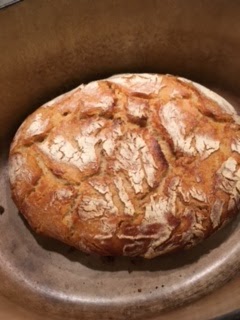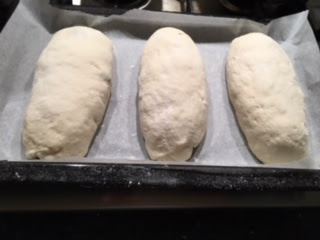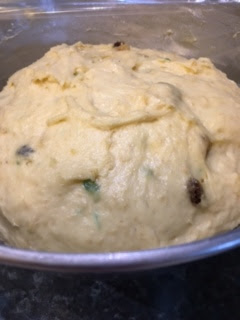French Bread.
I have been baking the
Boule, and I did a great job. This time I am for a challenge, I am baking the Baguette using the new sourdough starter. I hope for the best that I will make it. For the French bread, the Baguette is the hardest bread to achieve.
It is based on Éric Kayser's recipe.
Baguette (adapted from Éric Kayser)

Makes 3 baguettes
Each about 300 g
Ingredients
500 g all-purpose plain flour
(plus extra for dusting)
325 ml warm water (20 degrees C)
100 g liquid sourdough starter
1/2 teaspoon dry yeast
10 g salt
Method
Kneading in a stand mixture
Put the flour and water in the bowl and mix for four minutes at a low speed.
Remove the bowl from the machine and cover it with a damp cloth.

Leave to rest for on the hour.
Add the starter, the yeast, and salt. Knead with the dough hook for 4 minutes at low speed, then for 7 minutes at high speed.
Shape into a ball and cover with a damp cloth. Let it rise for 1 hour and 30 minutes. It will have increased in volume by the end of the rising time.
Dust the work surface. Divide the dough into 3 equal pieces.
Fold each piece over on itself, pulling gently to stretch into a longish log. Cover with a damp cloth and leave to rest for 30 minutes.


Working with 1 piece of dough at a time, use the palm of your hand to flatten it gently. Alongside facing you, fold in a third towards the centre and press along the edge with your fingertips. Swivel the dough 180 degrees.
Fold in the other edge so that it overlaps in the centre and press with heel of your hand. Fold one one-half on top of the other, and seal the edges together with the heel of your hand.
With lightly floured hands, roll the Baguette out to 55 cm long, then pinch each end into a point. Shape the other Baguette the same way.
Carefully lift the baguettes onto a lightly floured baker's cloth seams underneath. Separate them by making folds in the cloth. Cover with a damp cloth and leave to proof for 1 hour 40 minutes, by which time the Baguette will have increased in volume.
Place a baking sheet on the bottom shelf of the oven and preheat to 230 degrees C. Gently place the baguettes, seam down on another baking sheet lined with parchment paper. Dust with flour and make four evenly spaced oblique slashes along the length of each Baguette. Just before putting the Baguette in the oven, pour 50 g of water onto the preheated baking sheet. Bake for 20 minutes.
Baguettes were slashed/scored before baking, sorry that I forgot to take the picture.
Freshly Baked Baguettes
The shaping of the Baguette I did it my own way, as I don't have the right baking-tin size, the Baguette are smaller than the normal one.
From the dough, it made four small baguettes with a funny shape.
The scoring did not spit enough during the baking, the bread does not appear as pretty as it should be.
The crust is crusty, the crumb is chewy. I think it is good enough, but by far it's not perfect.
The sourdough starter: so far, I used 100 m, and I am planning to use another 100 m for the next baking. 300 g the starter has remained. From here the starter needs a feed to keep alive.
To care for the sourdough starter.
The starter will remain alive for an average of 3 days after it has been refreshed. Accordingly, it should be refreshed at 3-day intervals by adding 50% of its own weight in water and flour. For instance, if you have 300 g of starter remaining, add 75 flour and 75 g water.
Remember that starter is a living thing and that you need to nourish it to keep it alive. If you will not be baking bread for several days, or if the ambient temperature rises, seal the jar tightly and store it in the refrigerator, where it will keep for several weeks. You can adapt the initial quantity of starter, depending on how often you plan to bake (The Larousse Book Of Bread by Éric Kayser)
All the best to you all. Do the right thing, feed the starter when it need be, keep it well and you could have this sourdough starter for a long time, could be forever.
I will be baking sourdough bread now and then, and I will try to do Eric's method, but I am willing to change some of the ingredients such as instead using the fresh baker yeast, I will be using the dry yeast. Another word, the result could be different from the book, but I am happy enough.
As my Baguette, the latest of my baking was not perfect, not even close. I was disappointed, but
I will try again, maybe better next time.
Until Next Post
Susy
























































